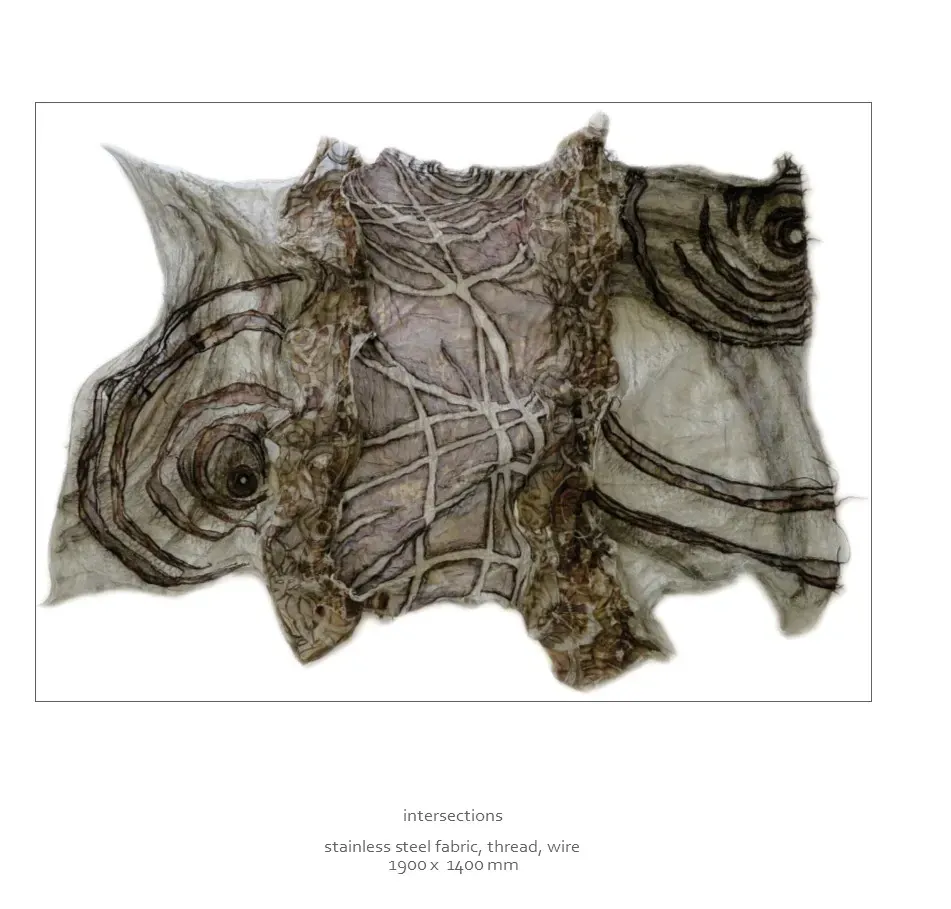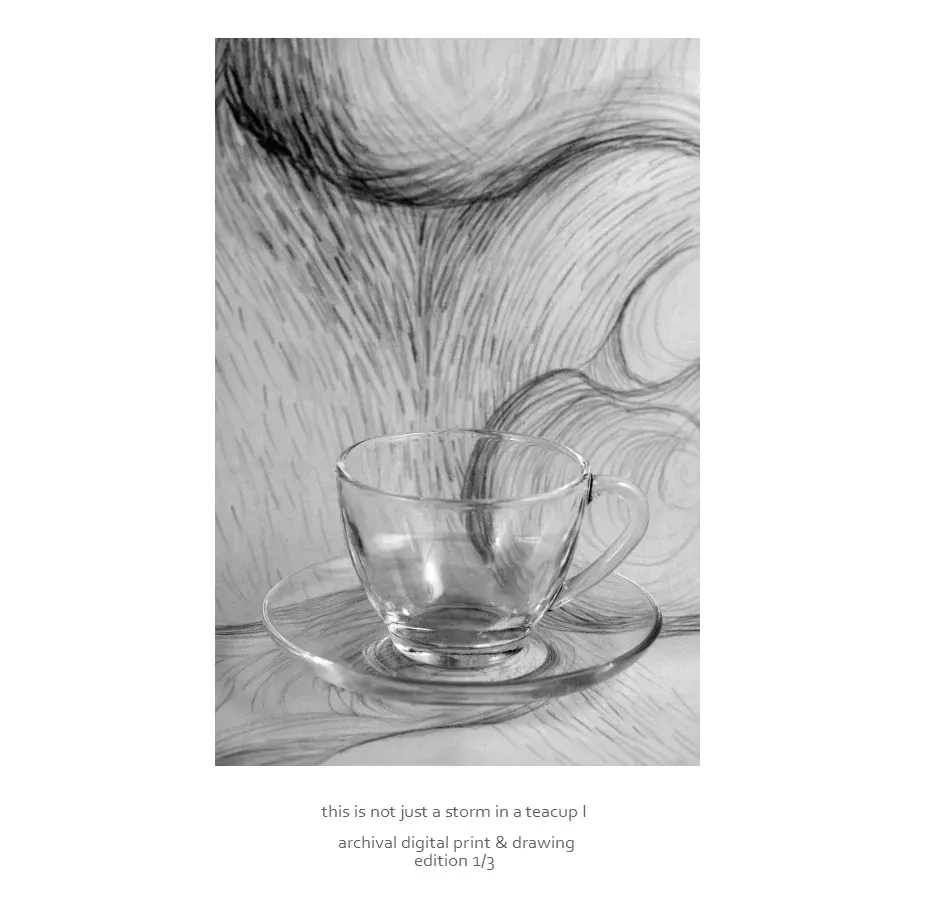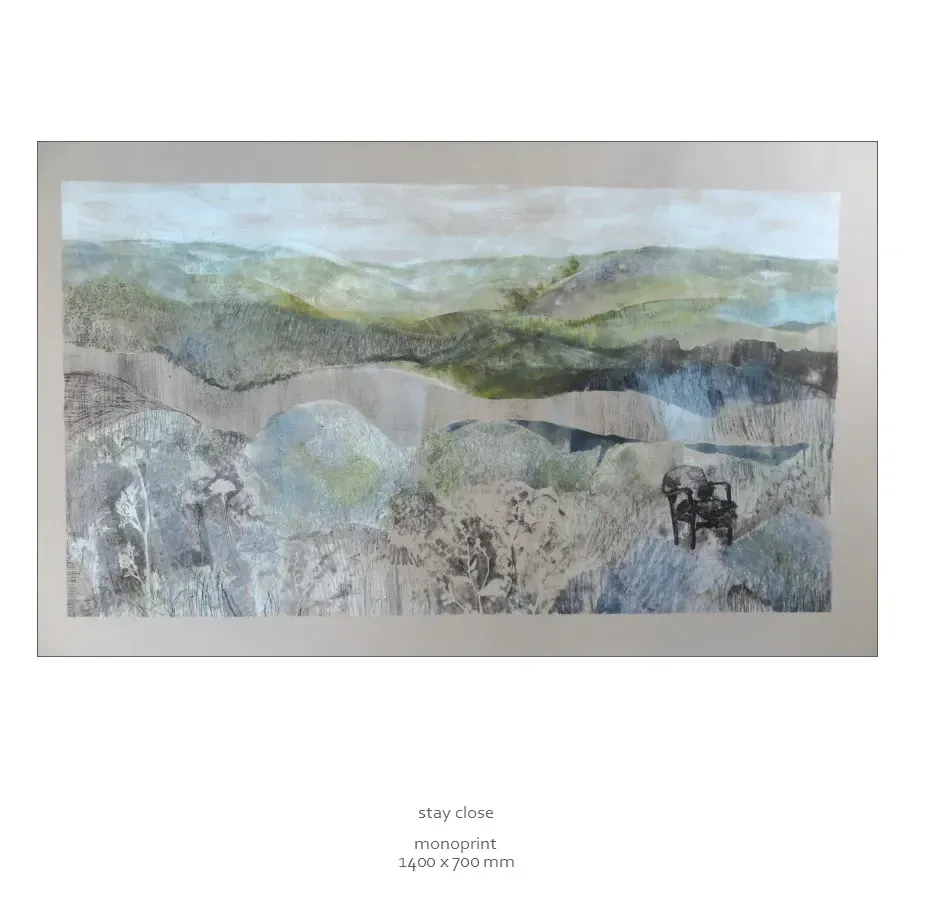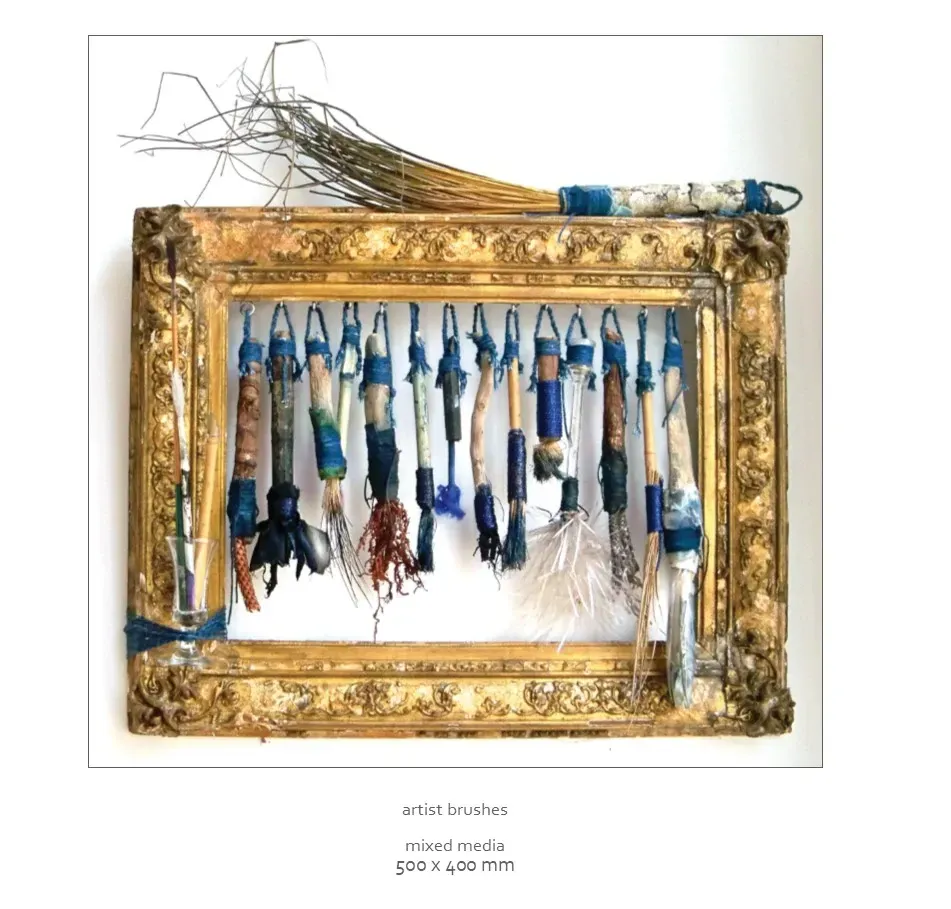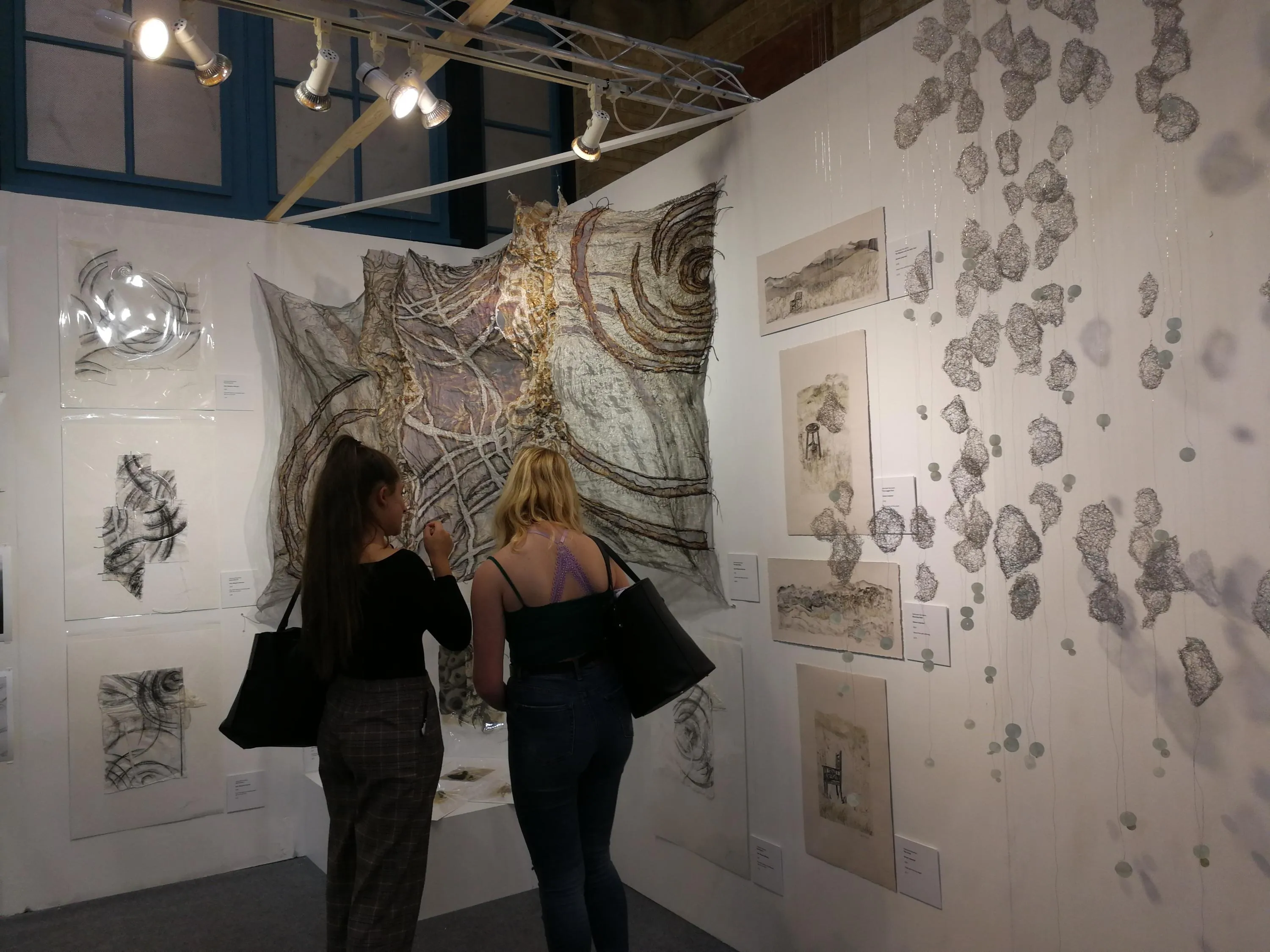UK Success for New Zealand Artists
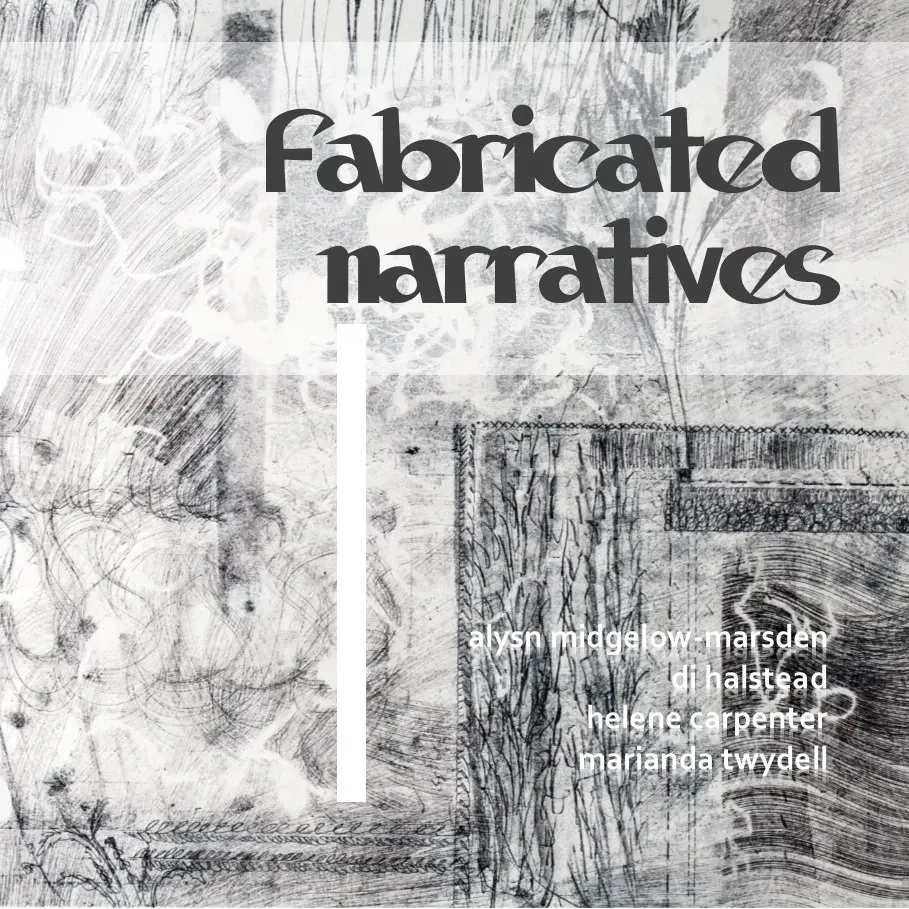
Talk about crossovers! Four artists bringing a variety of artistic practices, a variety of origins, a variety of inspirations and influences, came together in a project called ‘Fabricated Narratives’ to create and exhibit in venues across Britain and Ireland. We are Alysn Midgelow-Marsden (web: alysnmidgelowmarsden.com), Helene Carpenter (Instagram: takatu_studio_helen), Di Halstead (web:djhalstead.weebly.com) and Marianda Twydell (fb: @marianda.artist).
Alysn’s speciality is fine art using textiles or textile based techniques. Marianda has begun recently exploring the textile art areas of her new practice, having previously been a successful stained glass artist. Di describes herself as a mixed media artist with a specialism in photography, and Helene, a painter now exploring clay, print and sculptural forms. Our common denominator was that we all have stories to portray and we have an existing connection through our concepts to the title ‘Fabricated Narratives’.
Through Alysn’s international profile and history of gallery ownership, she was offered an exhibition opportunity at the best known, largest and most highly attended textile show series in the UK and Europe. Though for historical reasons the exhibition is slightly dubiously named ‘The Knitting and Stitching Show’, this annual touring show draws almost 100,000 visitors from Britain, Ireland, all over Europe, America, Canada and of course Australia and New Zealand. The Autumn show series sets up camps in Alexandra Palace (London, UK), the Royal Dublin Showgrounds (Ireland) and Harrogate International Centre (Harrogate, UK). To be invited to exhibit is an awesome opportunity. The anticipated benefits were networking, profile and sales, but all of the artists say they were unprepared for the other benefits to have arisen.
'Fabricated Narratives' was curated by Alysn, whose pieces are known for breaking boundaries of textile methods. Her work uses tactility and scale to impress, she is a virtuoso in redefining concepts of traditional textiles, elevating thread and form into fine art pieces with a strong conceptual ideal. Her vision for generating this touring exhibition drew strongly from this attitude. Her awareness was that textile exhibitions tend to be rather like self-contained ghettos showcasing a textile tribe, diligent and highly skilled, yet specific in nature. She says: ‘For this opportunity I wanted to turn the tables and to collaborate with selected artists whose work was not primarily or at all fabric or stitch based, and to push back the boundaries just a little by taking non-textile based works to a textile based show. As a curator is my belief that combining textiles with other art mediums in the public eye has to be the future of textiles if their reputation as an expressive medium in the wider world is to continue to develop. To display the meaning and intent of the piece or the maker should be key, textiles as art cannot be simply justified by technical expertise.’
The exhibition concept was to create work which examined ‘fabricated narratives’ or which fabricated stories for objects or drew on stories for fabrics. Whether historically accurate or playfully inventive, each work in the exhibition was to be part of a fabricated story. The works for this directly related to the regular practice of the participants.
The outcome
The anonymity of showing overseas in a new environment was a challenging and potentially risky proposition for some of the participants, and to invite non-textile artists was a risk for the reputation of the curator. But risks are necessary and should be grasped with both hands. The exhibitions did what good exhibitions should do: it raised a deadline for evaluation of personal work; generated an audience for the work; created interest for future efforts by the participants; and is a stand point from which to make or move forward personal practices. The works exhibited stood, as they should, on their own merits. As artists this is the best resolution of long hours in the studio. To have their stories received and understood is a great success in addition to sales, exhibition and lecturing bookings and new connections and opportunities developed.
The story of an exhibition is never just about the creation of the final works and there are many people and phases involved along the way. In this case the artists also have to send huge thanks and appreciation to Ingrid Jellick, filmmaker, who created a film especially for the occasion and to Steve Balaam (Big Ant Video) who added the music, Upper Street Events for the exhibition invitation and support.
You can see more on the web and facebook (W:fabricatednarratives.com, FB: @fabricatednarratives) and the video on Vimeo: https://vimeo.com/289982033
The Collaborative Negotiation
A key feature of the project was to co-share experience and develop an understanding of new skills within a robust conceptual practice. When artists come together to collaborate it can be catastrophic in terms of aesthetic and personality, so it was necessary for the group to avoid this pitfall. The challenge was to create ‘work’ which examined our own processes, based on artwork being a visual communication tool, ‘a story’. The aim was to develop new work individually which was influenced in some way by a greater understanding of each other’s creativity. Successful outcomes were not to be measured in terms of the final ‘piece’ but the influence of the process and the exploration of materials and conceptual practice. The collective consciousness of the group grew with each meeting with the artists wanting to show a response to this as a chance to reset conceptual beliefs in terms of critical thinking.
Words on Collaboration from the participants:
Alysn: Quite a novel thought this, instead of being the instigator, the teacher, the mover; I was going to have to respond and create a work from an unchosen source given to me by another, which had their concerns and personality etched into it. Even given the assurance that we could do absolutely whatever we wished with each offering, it still became a responsibility. A good thing? A challenge? How to take the inspiration of another artist and honour that whilst making something your own? Interestingly each piece became a unique outcome with unexpected links between us as artists showing through.
Marianda: I love collaborating with others, the to and the fro, the sharing and the ideas. In the first instance I found myself feeling that I was failing, then realised that I was thinking about living up to my perceived standards of others, rather than being myself. Being able to recognise this eventually allowed me to be more authentic in my response, to do something more intuitive and ultimately satisfying.
Di: The collaborative part of our project was much harder than I thought. I found it difficult to receive something that wasn't mine, make it my own and then hand it on. In the end I found it began to inform my own art making and I was glad of the challenge. It helped me to open my mind and I enjoyed bridging my ideas with those presented to me, stepping off from the artwork of others has really extended this project for me. I experienced momentum, professionalism, making art instead of just doing art, collegiality, a continuance of skill, collaboration and fortitude. I feel I have really grown and flourished from this experience.
Helene: The collaborative process allowed us to discuss process and ideas with enthusiasm and without critical evaluation. I found that earlier ‘rejects’ have become vital and I have been far more inspired by the concept of the " process" rather than making the objects, it has allowed a playfulness and a chance to experiment and grow. The distillation process of our time and thoughts shared together has been fulfilling and rewarding. Being influenced by Alysn’s textile expertise brought a new necessity to explore textile processes. To record and preserve ‘a stitch in time’ has been essential in my new print and mark-making process. Di’s knowledge of New Zealand artists and arts practice has been an invaluable resource for me, as is Marianda’s playful optimism in her exploration of the found object. It is this bringing together of experiences that had been really rewarding and challenging. Our collaborative process has opened up new avenues of discovery within my personal practice.
The future:
Alysn is now working towards events and exhibition opportunities in New Zealand which will develop the story and success of Fabricated Narratives. The artists will continue to create both individual and collaborative pieces for audiences in New Zealand and beyond.
The Artists
Alysn Midgelow-Marsden
Alysn Midgelow-Marsden is an experienced freelance artist, an author, tutor and gallery director (The Beetroot Tree, UK and The Geoff Wilson Gallery, NZ). Based in New Zealand she travels internationally to teach and exhibit.
Awards include: 1st place National Patchwork Championship, Wearable Art, UK, 1998, 1999
1st place Bernina Award for the most Innovative use of the sewing machine, NZ, 2015
1st place Timeless Textiles (Brooch #2), AUS, 2018.
She has an experimental and curious nature leading to continuously evolving and changing works. A scientific background and continuing interest in the natural environment and it’s connection with human existence is often combined with a fascination about the traditions of widely differing cultures and times. The works are at once personal and universal, disconcerting and fascinating. Working primarily in metal shims and woven metal fabrics, but also finding power in papers, fibres, paints and especially distressing and burning to alter surfaces.
For Fabricated Narratives:‘Messages, stories and narratives given shape and colour through abstract form to convey stunning and powerful messages. The water: Interactions, overlaps, ripples, refractions. The cocoon: A transformative place, quiet change, protection. Many small transformations, many small droplets combined.’
Marianda Twydell
Marianda Twydell was a founder member of an artist co-operative, (the Eagle Gallery) in Bedford England, and built experience of group shows leading to solo exhibitions. More recently transitioning to a life spent travelling between NZ and the UK, her emphasis has become more collaborative, establishing two studios and co-ordinating numerous local exhibitions.
For Fabricated Narratives: ‘I respond to the environment I find myself in by working with things I find or see in daily life, making additions and new combinations. Having previously worked with costly materials I now enjoy the freedom of working with items of less monetary value; ephemera from daily life. I examine the materiality of these objects, consider the chances and choices that have led to them being as they now are, then form another part of their story. My state of mind at this time is also part of the process, I aim to be fully present, mindful and respectful, living my creativity.’
Helene Carpenter
Helene Carpenter attended the Wimbledon College of Art, graduating with Honours in 1992. Having taught as a Lecturer at the Lasalle College of the Arts, Singapore, for 11 years, she currently works and teaches from her coastal studio (Takatu Studio) on the Tawharanui Peninsula, just north of Auckland. Historically a predominant focus of her working practice has been the development of creative thinking and professional practices with young individuals wishing to pursue a creative practice career. This has taken the form of exhibition and mentorship programs in the UK, Singapore and in Auckland. Her own work has, and continues to be, exhibited internationally and held in private collections across Australia, South East Asia, America and Europe.
Focusing on materiality, Helene works predominantly within the boundary of painting and drawing. Fundamentally she is inspired by her surroundings; be it the landscapes itself, the people who exist within it, and the history of ‘place’. Since moving to New Zealand in 2012, her work has been a responsive exploration to this new physical surrounding. Helene is currently exploring the boundary between the drawn, the transferred image, and sculpture.
For Fabricated Narratives:‘The generation of the Looking Books & prints for the Fabricated Narratives exhibition are telling stories of the “then and now”, the journeys we make in life. Chairs and landscape became a metaphor in my work for hopes and memories and in the process I bonded with the New Zealand landscape and my place in it. The monoprinting marks are made by my hands and memories of the drawings made in sketchbooks. The fleeting marks in my drawing process depend on pressure and form, you can only make one mark, the process only allows that, a very different way of working to that of paint.
Di Halstead
Di Halstead works as a Gallery Educator at Auckland Art Gallery Toi o Tamaki. She worked as a Photography Lecturer at Dunedin School of Art for fourteen years, where she was Head of Photography for two years. She has a Diploma of Fine Arts with Honour’s from there and a Master of Fine Art from RMIT, Melbourne, Australia.
Awards:
Art Addiction Award, Sweden, Excellence, 1997
Cleveland Art Award, Highly Commended, Dunedin, 1998.
Her art practice has centred on identity - cultural and personal and ecological issues. She is interested in powerful compositions that fire our imaginations, hold our grief or give us hope. Partly our thoughts and partly the image itself. At times she crosses boundaries with other mediums, including screen-printing, textiles, painting and drawing.
For Fabricated Narratives:‘Clouded’ is a series of images that is about our perceptions, images which not only hold our emotions, but speaks of an environmental narrative. This is not just ‘a storm in a teacup’, a fleeting story, it is in fact a more serious cry for the care of our planet. The teacup acts as an agent to frame the storm, it claims the power of the everyday and holds us to the true nature of the story.’
Fabricated Narratives Website, Fabricated Narratives Facebook
